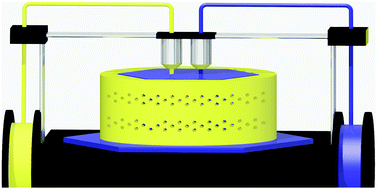当前位置:
X-MOL 学术
›
Chem. Soc. Rev.
›
论文详情
Our official English website, www.x-mol.net, welcomes your feedback! (Note: you will need to create a separate account there.)
3D printing in chemical engineering and catalytic technology: structured catalysts, mixers and reactors
Chemical Society Reviews ( IF 46.2 ) Pub Date : 2017-11-13 00:00:00 , DOI: 10.1039/c7cs00631d Cesar Parra-Cabrera 1, 2, 3, 4 , Clement Achille 1, 2, 3, 4 , Simon Kuhn 2, 3, 4, 5 , Rob Ameloot 1, 2, 3, 4
Chemical Society Reviews ( IF 46.2 ) Pub Date : 2017-11-13 00:00:00 , DOI: 10.1039/c7cs00631d Cesar Parra-Cabrera 1, 2, 3, 4 , Clement Achille 1, 2, 3, 4 , Simon Kuhn 2, 3, 4, 5 , Rob Ameloot 1, 2, 3, 4
Affiliation

|
Computer-aided fabrication technologies combined with simulation and data processing approaches are changing our way of manufacturing and designing functional objects. Also in the field of catalytic technology and chemical engineering the impact of additive manufacturing, also referred to as 3D printing, is steadily increasing thanks to a rapidly decreasing equipment threshold. Although still in an early stage, the rapid and seamless transition between digital data and physical objects enabled by these fabrication tools will benefit both research and manufacture of reactors and structured catalysts. Additive manufacturing closes the gap between theory and experiment, by enabling accurate fabrication of geometries optimized through computational fluid dynamics and the experimental evaluation of their properties. This review highlights the research using 3D printing and computational modeling as digital tools for the design and fabrication of reactors and structured catalysts. The goal of this contribution is to stimulate interactions at the crossroads of chemistry and materials science on the one hand and digital fabrication and computational modeling on the other.
中文翻译:

化学工程和催化技术中的3D打印:结构化催化剂,混合器和反应器
结合仿真和数据处理方法的计算机辅助制造技术正在改变我们制造和设计功能对象的方式。同样在催化技术和化学工程领域,由于设备阈值的迅速降低,增材制造(也称为3D打印)的影响正在稳步增加。尽管仍处于早期阶段,但通过这些制造工具实现的数字数据与物理对象之间的快速无缝过渡将有益于反应器和结构化催化剂的研究与制造。增材制造通过精确地制造通过计算流体动力学和对其性能进行实验评估而优化的几何形状,从而弥合了理论与实验之间的鸿沟。这篇综述重点介绍了使用3D打印和计算模型作为反应器和结构化催化剂的设计和制造的数字工具的研究。这一贡献的目的是一方面促进化学和材料科学的十字路口,另一方面促进数字制造和计算模型的相互作用。
更新日期:2017-11-13
中文翻译:

化学工程和催化技术中的3D打印:结构化催化剂,混合器和反应器
结合仿真和数据处理方法的计算机辅助制造技术正在改变我们制造和设计功能对象的方式。同样在催化技术和化学工程领域,由于设备阈值的迅速降低,增材制造(也称为3D打印)的影响正在稳步增加。尽管仍处于早期阶段,但通过这些制造工具实现的数字数据与物理对象之间的快速无缝过渡将有益于反应器和结构化催化剂的研究与制造。增材制造通过精确地制造通过计算流体动力学和对其性能进行实验评估而优化的几何形状,从而弥合了理论与实验之间的鸿沟。这篇综述重点介绍了使用3D打印和计算模型作为反应器和结构化催化剂的设计和制造的数字工具的研究。这一贡献的目的是一方面促进化学和材料科学的十字路口,另一方面促进数字制造和计算模型的相互作用。



























 京公网安备 11010802027423号
京公网安备 11010802027423号